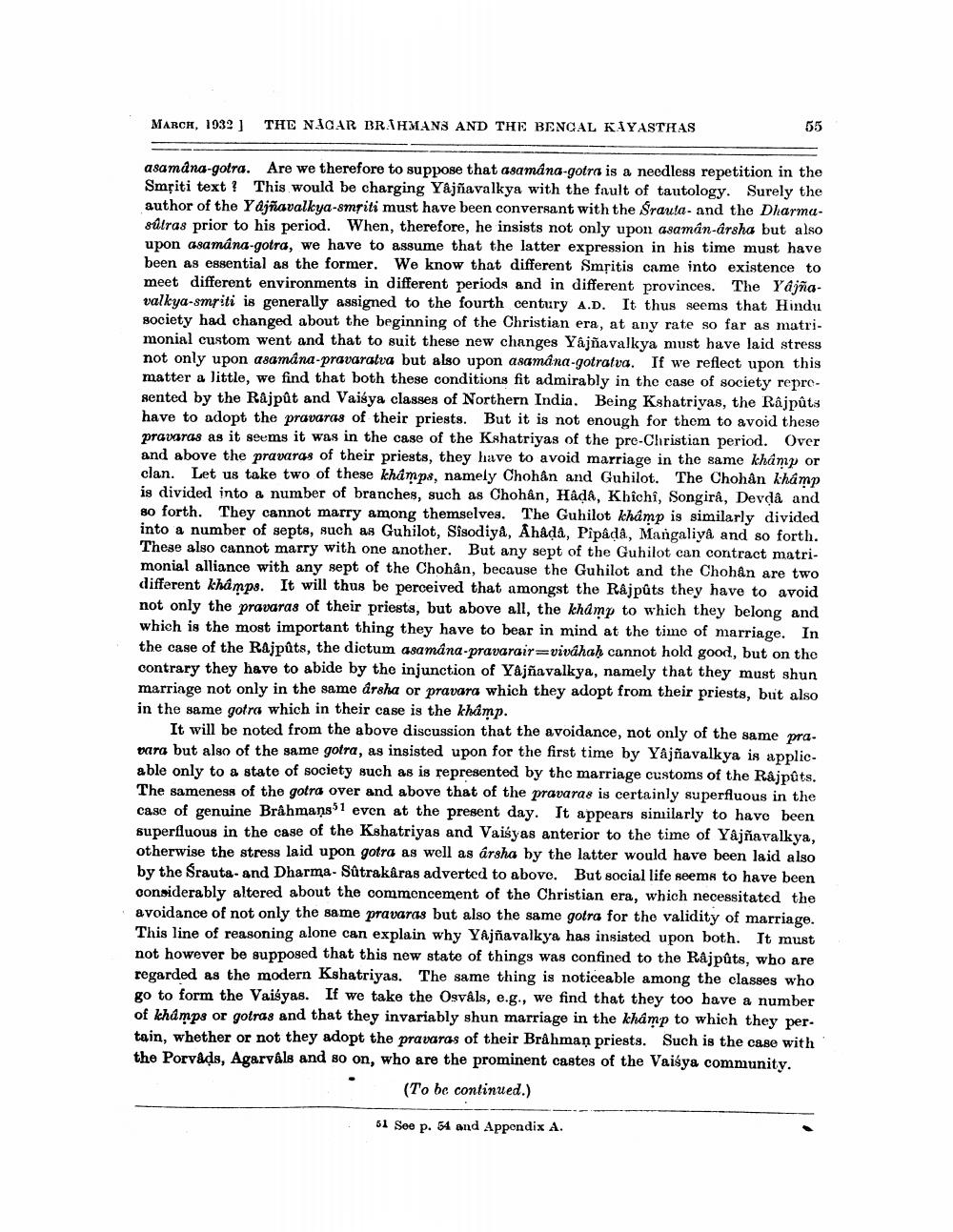________________
MARCH, 1932] THE NICAR BRAHMANS AND THE BENCAL KAYASTHAS
55
asamâna-gotra. Are we therefore to suppose that asamâna-gotra is a needless repetition in the Smțiti text? This would be charging Yajñavalkya with the fault of tautology. Surely the author of the Yajñavalkya-smriti must have been conversant with the Srauta- and the Dharmasútras prior to his period. When, therefore, he insists not only upon asamán-arsha but also upon asamána-gotra, we have to assume that the latter expression in his time must have been as essential as the former. We know that different Smsitis came into existence to meet different environments in different periods and in different provinces. The Yáñavalkya-smriti is generally assigned to the fourth century A.D. It thus seems that Hindu society had changed about the beginning of the Christian era, at any rate so far as matrimonial custom went and that to suit these new changes Yájñavalkya must have laid stress not only upon asamána-pravaratva but also upon asamána-gotratva. If we reflect upon this matter a little, we find that both these conditions fit admirably in the case of society represented by the Rajput and Vaisya classes of Northern India. Being Kshatriyas, the Rainûts have to adopt the pravaras of their priests. But it is not enough for them to avoid these pravaras as it seems it was in the case of the Kshatriyas of the pre-Christian period. Over and above the pravaras of their priests, they have to avoid marriage in the same khâmp or clan. Let us take two of these khamps, namely Chohan and Guhilot. The Chohan khámp is divided into a number of branches, such as Chohán, Háda, Khichi, Songirå, Devda and 80 forth. They cannot marry among themselves. The Guhilot khámp is similarly divided into a number of septe, such as Guhilot, Sisodiya, Ahada, Pipâda, Mangaliya and so forth. These also cannot marry with one another. But any sept of the Guhilot can contract matrimonial alliance with any sept of the Chohân, because the Guhilot and the Chohan are two different khámps. It will thus be perceived that amongst the Rajputs they have to avoid not only the pravaras of their priests, but above all, the khamp to which they belong and which is the most important thing they have to bear in mind at the time of marriage. In the case of the Rajputs, the dictum asamána-pravarair=viváhah cannot hold good, but on the contrary they have to abide by the injunction of Yajñavalkya, namely that they must shun marriage not only in the same arsha or pravara which they adopt from their priests, but also in the same gotra which in their case is the khamp.
It will be noted from the above discussion that the avoidance, not only of the same pra. vara but also of the same gotra, as insisted upon for the first time by Yajñavalkya is applicable only to a state of society such as is represented by the marriage customs of the Rajputs. The sameness of the golra over and above that of the pravaras is certainly superfluous in the case of genuine Brâhmans51 even at the present day. It appears similarly to have been superfluous in the case of the Kshatriyas and Vaisyas anterior to the time of Yajñavalkya, otherwise the stress laid upon gotra as well as ársha by the latter would have been laid also by the Srauta-and Dharma-Sätrakaras adverted to above. But social life seems to have been considerably altered about the commencement of the Christian era, which necessitated the avoidance of not only the same pravaras but also the same gotra for the validity of marriage. This line of reasoning alone can explain why Yajñavalkya has insisted upon both. It must not however be supposed that this new state of things was confined to the Råjpûts, who are regarded as the modern Kshatriyas. The same thing is noticeable among the classes who go to form the Vaisyas. If we take the Osvals, e.g., we find that they too have a number of khamps or gotras and that they invariably shun marriage in the khâmp to which they per. tain, whether or not they adopt the pravaras of their Brahman priests. Such is the case with the Porvåds, Agarvals and so on, who are the prominent castes of the Vaiśya community.
(To be continued.)
61 Soe p. 54 and Appendix A.




